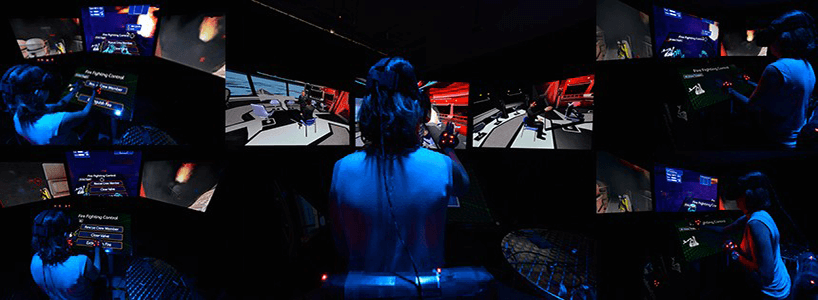Increasingly the U.S. military is turning to virtual tools to prepare warfighters for real world situations. The military hopes its investments today will help it cut costs and save time into the future.
This includes the Digital Soldier, a project from consulting firm Booz Allen Hamilton which is being developed in Huntsville, AL as way to put soldiers in very intense environments – but still out of real harm’s way.
The Digital Soldier program, which is part of a $500 million contract with the Army to maximize soldier performance, was designed to track data including an individual’s heart rate, skin temperature and eye movement. This data can be collected to help soldiers during training, and prepare them for combat through familiarity with what could be very stressful situations.
The United States Air Force’s tech incubator, AFWERX, has awarded a $1.5 million development grant to Santa Monica, CA-based Red 6 to develop a combat training system utilizing augmented reality (AR)
The goal of the Red 6 program is to help the USAF overcome its pilot shortage and help train future pilots prepare for close range air-to-air combat, ground attacks and refueling missions – all of which can be complex, expensive and dangerous in the real world. Even the large and expensive simulators were found to have limited effectiveness, and augmented reality could enable better training capabilities.
Beyond Physical Combat
It isn’t just combat training where virtual reality is being put to use. This month Silver Spring, MD-based Resolvn was awarded a contract to develop and maintain the U.S. Navy’s high-fidelity virtual training range on the PCTE platform. It consists of 14 connected networks including those of a power plant, multiple internet service providers, a DoD facility and municipal buildings, among others.
The range’s modular design could allow training managers and cyber operators to simulate a cyber attack without the actual threat.
“How do you give them a realistic setting without letting bad actors breach your network?” noted Peter Hay, director of strategy and innovation at Resolvn, Inc.
“This is very much like the U.S. Army doing an exercise in the field – it is just a field until you put the ‘Op Force’ in place, so this is a way to create a cyber exercise,” Hay told ClearanceJobs.
Beyond Simulations
AR and VR provide greater immersion than past simulators or wargames.
“We’ve had military simulators for some time, and they have typically been wickedly expensive to build and best for things like simulating flying, operating tanks, or navigating ships,” explained Rob Enderle, principal analyst at the Enderle Group.
“This dedication to detail allows the designer to create a fully functional cockpit/helm/control station and then, with the use of displays and robotics create a pretty accurate feeling of what might happen,” Enderle told ClearanceJobs. “With VR helmets, they can cut a lot of the cost, and with mixed reality technology, they can still integrate real control surfaces into the experience without having to recreate the word space – you can have the dashboards emulated and have the switches and controls in the normal places.”
All this could lend itself to dedicated tasks like gunnery or helm control, “but when you need to emulate the entire bridge you’d likely be better off with the old way of doing things, because you want to see people physically move around the environment,” added Enderle. “As long as you understand VR’s current weaknesses, you should be able to create dedicated training scenarios and systems that cost a fraction of what they once did, are easier to update, and are even more realistic than the simulators of years past. But you need to keep in mind the weaknesses or the people will be inadequately trained for the real thing.”
With this in mind it is easy to see why the U.S. military is investing millions now. It’s a relatively small investment to bring down the training costs, and also provide a more immersing experience to soldiers, sailors, airmen and marines.
“The U.S. Navy is using VR training for everything from pilots to flight crews,” noted Jim McGregor of TIRIAS Research. “And as we have seen from avionics simulation training, it is effective in improving response times, enhancing strategy development, and reducing accidents. The more realistic you can make the simulation environment, the more effective the results.”
Gamification Concerns
VR is very much the natural next step for improving the training of military personnel, however some have expressed concern that it could become too much like a video game, rather than a true training tool.
“I don’t really think that there is a concern about it being too much like a game,” McGregor told ClearanceJobs. “When you are on a flight deck with the wind, the jet engines, and utter chaos going on around you, I think it’s pretty easy for the body to determine the difference between the simulation and the real thing.”
However, gamification is a part of some of these simulations.
“Gamification has a valuable training aspect,” said Hay. “We use it in individual training for specific skills, where it is about meeting goals – but we don’t embrace it in most exercises. Ultimately you play like you practice, and we want to practice like we fight.”
Whatever the battlefield of the future – whether it is a physical one or a cyber-based one – VR can help those warfighters prepare for the unknown.
“It will not only reduce accidents, but it will also help improve procedures and potentially even the equipment being used,” said McGregor. “Hopefully, it eventually pulls people out of being in harm’s way.”



